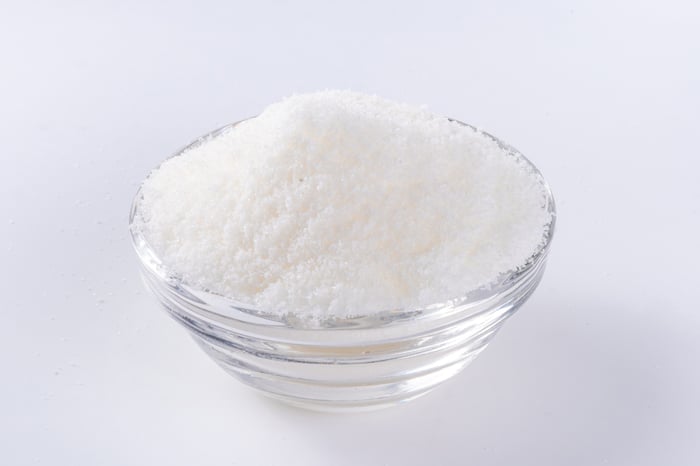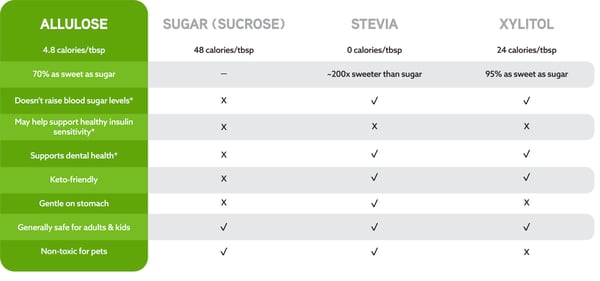
Weight management and blood sugar support are two of the most common concerns of patients. Dysfunctions in these areas have become epidemic.1 Furthermore, 30.7% of U.S. adults are overweight.2
This has put a spotlight on foods with added sugar, also known as sucrose or table sugar. Sucrose contains two simple sugar molecules linked together: glucose and fructose.
Excess sucrose consumption contributes to many harmful health conditions. A high-sugar diet isn’t good for the brain, making it harder to think and maintain a good mood. Sugar contributes to the breakdown of teeth, too.3-8 It can also deplete vitamin C levels.9 This is concerning, given that Americans eat an average of 69.8 pounds of refined sugar (sucrose) per capita annually, according to the United States Department of Agriculture (USDA).10
Even more concerning than sucrose are the health effects of high-fructose corn syrup (HFCS), which is consumed to the tune of 39.5 pounds per person, each year.10 HFCS is a sweetener made from corn starch that has been processed to convert some of its glucose into fructose, making it sweeter than regular corn syrup. Like sucrose, it contains nearly equal amounts of the simple sugars, glucose and fructose.11
Diets high in HFCS are known to impair cardiometabolic health.11 HFCS intake by way of processed foods in the United States increased dramatically from the 1970s to 2000s and has been suggested as a factor in the increased incidence of overweight during that same time period.12
A healthy alternative to sugar and HFCS is needed. Research is now indicating that the best alternative to sugar may be allulose. In this blog, you’ll learn about allulose, its track record as a low-calorie sweetener, and how it compares with xylitol, monk fruit, and stevia. You may be surprised to learn of its beneficial effects on blood sugar, insulin, and body weight!* For all these reasons, DaVinci® Laboratories is releasing their first-ever premium gummy vitamin starring allulose as its low-calorie sweetener.

What Is Allulose?
D-Allulose (also known as D-Psicose or, simply, allulose) is a low-calorie sweetener that occurs in small doses in wheat, fruits such as raisins, kiwis, and figs, and other sweet foods such as molasses, brown sugar, and maple syrup.
Naturally sourced from non-GMO corn, allulose is a c-3 epimer of fructose, meaning that it has the same chemical formula and connectivity of atoms, but a different three-dimensional arrangement than fructose. Therefore, it follows the same absorption, distribution, and excretion routes as fructose, but unlike fructose, the human body does not break down or metabolize allulose, since it is a non-digestible carbohydrate. This leads to an almost complete renal excretion in the urine of the absorbed dose, resulting in a very low caloric response.*
Due to its pleasant taste and health-promoting properties, allulose has been used as a replacement for sugar for nearly ten years in ketogenic baking recipes.* Allulose is only 70% as sweet as sucrose (table sugar) but has less than 10% of its caloric value, a glycemic index of 0, and does not directly cause a blood-sugar rise.* It’s keto-friendly, vegetarian, and supports dental health.*13
The Research Behind Allulose Benefits
Mounting scientific studies, government recognition, and regular use by consumers are suggesting that allulose may have a role in weight management, blood sugar balance, insulin metabolism, and more.* Popular in keto-friendly baking mixes and prepared foods, you may already be enjoying the benefits and flavor of allulose.
Allulose Triggers GLP-1 Release*
Supporting the release of glucagon-like peptide 1 (GLP-1) has become a popular weight management strategy. Increasing the production of the intestinal hormone GLP-1 supports a healthy body weight by managing appetite and keeping blood sugar stable. Human research shows that D-allulose increases the release of gastrointestinal (GI) satiation hormones, such as GLP-1, peptide tyrosine tyrosine (PYY), and cholecystokinin (CCK).*14 In a randomized, controlled, double-blind, crossover study, 18 participants received an intragastric administration of 25 grams D-allulose. The study found that D-allulose caused a significant release of CCK, GLP-1, and PYY compared with the control. D-allulose has other mechanisms by which it supports a healthy weight, too.*
For more diet and lifestyle approaches to support GLP-1 levels and optimum body weight, read our blog: Diet, Lifestyle & GLP-1 Support Supplements: An Integrative Approach to Weight Management.*
Allulose Blunts the Effects of Sucrose on Blood Sugar and Insulin*
Another important component of a weight management program is D-allulose’s ability to support healthy blood sugar and insulin.* In a prospective, randomized, double-blind, crossover study, participants were given five oral sucrose tolerance tests (OSTT) with escalating doses of D-allulose (0, 2.5, 5, 7.5 or 10 grams) along with a 50 gram sucrose beverage.15
Researchers drew blood samples immediately before the subjects drank the D-allulose and sucrose beverage and at 30, 60, 90, and 120 minutes afterward in order to measure plasma glucose and insulin. Thirty healthy subjects finished the study. The peak postprandial glucose and insulin levels were lower when D-allulose was added in a dose-dependent manner.
According to the study authors, “D-allulose has a suppression response on glucose and insulin shown by the decrease in postprandial plasma glucose and insulin levels following the addition of D-allulose to sucrose in a dose-dependent manner. The more D-allulose added, the less marked the glucose and insulin response occurred.”
Best Low-Calorie Sweetener for Metabolic Health*
Allulose holds potential for helping people with metabolic imbalances.* In a pilot study, researchers investigated the efficacy of a diet containing 8.5 grams of D-allulose compared to a standard diet in patients with type 2 diabetes.16 The study authors used an intermittently scanned continuous glucose monitoring system to compare the effects of the two diets. The study found that a diet containing D-allulose supported healthy postprandial blood glucose in type 2 diabetes patients compared with a strictly energy-controlled diet.* The results also showed that D-allulose protected against an overactive endogenous pancreatic insulin secretory capacity by reducing the insulin requirement.*
The results of these studies show that D-allulose is one of the best low-calorie sweeteners for people who want to support their metabolic health.*
Helps Promote Healthy Blood Sugar Levels*
D-allulose has equally important health benefits in people without pre-existing metabolic conditions. This was shown in a prospective, randomized, double-blind, placebo-controlled, crossover study in 30 subjects free of metabolic conditions.17 Study participants received a standard oral (50 gram) sucrose load and randomized to placebo or escalating doses of D-allulose (2.5, 5.0, 7.5, 10.0 grams). Subjects crossed over to the alternate study treatment after 7-14 days of wash out. The study authors measured plasma glucose and insulin levels before the sucrose load and at 30, 60, 90, and 120 min after ingestion.
In the D-allulose phase, participants experienced a dose-dependent reduction of plasma glucose at 30 minutes compared with placebo.* Specifically, the 7.5 gram and 10 gram doses led to a significantly lower glucose response.* In addition, at 30 minutes, D-allulose was associated with a trend towards lower insulin levels compared with placebo, which was significant with the 10 gram dose.*
Helps With Reduction of Body Fat
As a zero-calorie sweetener, D-allulose is a good choice for patients on a weight management program.* It has demonstrated impressive supportive results in this area, including a study of 121 Korean subjects aged 20 to 40 years with a body mass index ≥ 23 kg/m².18 In the randomized, controlled trial, participants were given sucralose, D-allulose 4 grams × 2 times/day, or D-allulose 7 grams × 2 times/day. Following the ingestion of D-allulose, body fat percentage and body fat mass significantly declined.* Compared to the sucralose group, the group given the higher dose of D-allulose had a significant decrease in not only body mass index, but also total abdominal and subcutaneous fat areas, as measured by CT scans.*
Is Allulose Safe?
The FDA considers D-allulose to be GRAS (generally recognized as safe) with an intake of less than 0.5 to 0.6 g per kg of body weight per day. The GRAS level for soft candies is 25 grams per day. A study of dosages up to 15 grams per day showed no adverse effects and most importantly, the participants had improved liver health scores.*19 Another study found that there were no gastrointestinal effects at 35 grams per day.17
The tolerable dose of D-allulose is estimated to be 30 to 35 grams for a 132-pound person taken as a single dose. Amounts above that dosage can result in gastrointestinal distress including gas, bloating, stomach upset, or diarrhea. Symptoms resolve when reducing the dosage below 30 grams per day. Scientists investigating the gastrointestinal tolerance of D-allulose found no cases of severe diarrhea or GI symptoms at dosages under 0.4 g/kg of body weight.20 Severe symptoms of diarrhea were observed at a dose of 0.5 g/kg body weight.
DaVinci® ADK Gummies contain less than 4 grams of allulose per daily recommended serving for adults. This is well below the GRAS level and means that users can still enjoy appropriate amounts of allulose in their other baked goods, candies, etc.
In children, D-allulose was found to be safe. Researchers gave children two different doses of D-allulose (2.5 grams per 120 ml and 4.3 grams per 120 ml) and concluded, “All in all, D-allulose was tolerated well in children, making this ingredient a good candidate to reformulate commercially produced goods by replacing added sugars with lower caloric content.”21

Allulose vs. Stevia
Stevia is extracted from the leaves of Stevia rebaudiana Bertoni, a shrub native to South America. Indigenous people have used stevia leaves for centuries in health-supporting products and sweet drinks. The sweetness of steviol glycosides is derived from two major chemical compounds from stevia, stevioside and rebaudioside A. Steviol glycosides preparations are 200 - 450% sweeter than sucrose and are noncaloric. Like D-allulose, they have a glycemic index of 0.
Steviol glycosides produce significant improvement in glucose metabolism in adult participants when compared with the control.22 When tested against the sweeteners sucralose and sucrose, stevia supported a healthy inflammatory response while other sweeteners increased inflammation markers.23 Other research found that stevia reduces energy intake and maintains healthy weight in healthy adults.24
The primary disadvantage of stevia is that it has an aftertaste that is unpleasing to certain people, which is why it’s usually combined with other sweeteners, some of which cause gastrointestinal distress if consumed in larger amounts. Allulose, on the other hand, has a more pleasant taste and does not have to be combined with other sweeteners.
Allulose vs. Erythritol and Xylitol
Erythritol and xylitol are low-calorie sugar alcohols. Erythritol is a naturally occurring monosaccharide sugar alcohol (polyol) found in a variety of fruits such as melons, pears, and grapes. Commercial large-scale erythritol production uses fermentation by yeast and yeast-like fungi as a cost-effective measure using substrates such as glucose, fructose, xylose, sucrose, cellulose, and glycerol. Since erythritol is found in fruits, the FDA also considers microbial-produced erythritol to be a natural sweetener. About 60% to 80% as sweet as sucrose, erythritol has a mild cooling effect in the mouth. It also is nearly completely noncaloric.
Like D-allulose, erythritol increases the secretion of GLP-1, an intestinal hormone associated with glucose control and supporting reduced appetite.14 Erythritol may also promote the release of (cholecystokinin) CCK and peptide tyrosine tyrosine (PYY), both of which are involved in signaling a feeling of fullness to the brain after eating.14 Furthermore, it suppresses ghrelin, the hormone primarily responsible for appetite stimulation. Lower ghrelin levels can support feelings of fullness and reduce food intake.
Xylitol is known as wood sugar, birch sugar, and meso-xylitol. It is a five-carbon polyol, produced in small amounts by the human body. Although it is found in fruits, vegetables, algae, and mushrooms, the levels are too low for commercial extraction, and it is commonly commercially produced from birch bark and corn cobs. Xylitol is used in many foods and pharmaceutical products in addition to sugar-free candies and chewing gums. Xylitol is as sweet as sucrose. It has a glycemic index of 13 and insulinemic index of 11 and provides 2.4 kcal/gram.
The biggest disadvantage of sugar alcohols such as xylitol and erythritol is that they can cause bloating, gas, and diarrhea. This usually occurs at high doses (>20 grams of xylitol) but some individuals are especially sensitive and laxative effects can occur at lower doses. D-Allulose’s GI effects don’t occur until over 30 – 35 grams, making it more suitable for people sensitive to the sugar alcohols.*17 In some cases, when patients are constipated, the laxative effect of sugar alcohols is an advantage.
Some studies indicated xylitol and erythritol were linked to cardiovascular risks.25,26 However, these studies were criticized for small sample size, the short-term duration of the studies, the fact the studies showed correlation not causation, and the studies used higher dosages that are not typical of everyday use.
Xylitol’s most significant advantage is its antiplaque, antigingivitic, and remineralizing properties, as demonstrated in a number of dental health studies.27-30
Xylitol can pose a threat to our companion animals. However, allulose has multiple safety studies in dogs. The safety profile of allulose in cats is still unknown.
Allulose vs. Monk Fruit
Monk fruit is also known as Swingle fruit or luo han guo. Monk fruit is made using a water extraction of the fruit, creating a solution of water-soluble solids, mainly cucurbitane glycoside and mogroside V. Monk fruit is 100 - 250% sweeter than table sugar and like D-allulose, has a glycemic index of 0.
Monk fruit is less sweet than some other sweeteners and can have bitter and metallic aftertaste at higher concentrations, which is why it’s often combined with other sweeteners. Substituting monk fruit for sugar can lead to drier baked goods. It also browns more quickly than sugar in heat applications like baking.
Allulose in a New Line of Gummies
Due to a significant amount of research demonstrating the benefits of allulose, this sugar-free sweetener was the perfect addition to DaVinci®'s new line of gummies, including ADK Gummies. This new gummy vitamin meets all the expectations of a premium gummy and contains three important nutrients: vitamins A, D, and K, critical for the health of bones, teeth, and the heart, as well as supporting immunity.* It is formulated with superior forms of the nutrients such as vitamin K2 in the form of menaquinone (MK-7) and vitamin D3 instead of D2.
ADK Gummies have all of the high-quality ingredients you want, without the ingredients you don’t want. The allulose in these multivitamin gummies is sourced from non-GMO corn and has a pleasant pineapple flavor. ADK Gummies have no preservatives or dyes. They are sugar-free, gluten-free, and soy-free. ADK Gummies are stored in an opaque bottle, which means the product is more shelf-stable and the beneficial ingredients will be better preserved.
ADK Gummies are third-party tested for microbes, soy, and gluten as well as the active ingredients to meet the label claim. This ensures proper potency, so users can trust that they are nourished with the amount of ingredients stated on the label. ADK Gummies are also tested for heavy metals and genetically modified ingredients initially when released to market and then retested whenever any formulation change occurs.
Find out what you should look for when shopping for high-quality gummy vitamins by reading our whitepaper: “Gummy Vitamins: How to choose the best gummy vitamins”.
References
- National … Statistics Report. Accessed March 13, 2025. https://www.cdc.gov/diabetes/php/data-research/index.html
- Overweight and …Statistics. National Institute of Diabetes and Digestive and Kidney Diseases. Accessed August 4, 2025. https://www.niddk.nih.gov/health-information/health-statistics/overweight-obesity
- Baratto PS, Sangalli CN, Leffa PDS, Valmorbida JL, Vitolo MR. Associations between children's dietary patterns, excessive weight gain…: cohort study nested to a randomized field trial. Rev Paul Pediatr. 2025;43:e2024117. doi:10.1590/1984-0462/2025/43/2024117
- Yang Q, Zhang Z, Gregg EW, Flanders WD, Merritt R, Hu FB. Added sugar intake and … JAMA Intern Med. Apr 2014;174(4):516-24. doi:10.1001/jamainternmed.2013.13563
- Yao S, Zhu J, Zhang H, et al. Prevalence and risk factors for dental caries among 3-year-old children in Shanghai, China: a cross-sectional study. BMC Oral Health. Jul 9 2025;25(1):1132. doi:10.1186/s12903-025-06454-9
- Gillespie KM, White MJ, Kemps E, Moore H, Dymond A, Bartlett SE. The Impact of Free and Added Sugars on Cognitive Function: A Systematic Review and Meta-Analysis. Nutrients. Dec 25 2023;16(1)doi:10.3390/nu16010075
- Jacques A, Chaaya N, Beecher K, Ali SA, Belmer A, Bartlett S. The impact of sugar consumption on stress driven, emotional and addictive behaviors. Neurosci Biobehav Rev. Aug 2019;103:178-199. doi:10.1016/j.neubiorev.2019.05.021
- Farsad-Naeimi A, Asjodi F, Omidian M, et al. Sugar consumption, sugar sweetened beverages and …: A systematic review and meta-analysis. Complement Ther Med. Sep 2020;53:102512. doi:10.1016/j.ctim.2020.102512
- Pappe CL, Peters B, Pivovarova-Ramich O, et al. Effects of a 4-week free-sugar avoidance during … An explorative randomized controlled clinical trial. J Periodontol. Jun 2025;96(6):675-690. doi:10.1002/jper.24-0208
- Abadam V. How sweet it is: Deliveries of caloric sweeteners for food and beverage use are on the rise. U.S. Department of Agriculture. Accessed August 9, 2025. https://www.ers.usda.gov/data-products/charts-of-note/chart-detail?chartId=105825
- Herman MA, Birnbaum MJ. Molecular aspects of fructose metabolism and … Cell Metab. Dec 7 2021;33(12):2329-2354. doi:10.1016/j.cmet.2021.09.010
- Jung S, Bae H, Song WS, Jang C. Dietary Fructose and Fructose-Induced … Annu Rev Nutr. Aug 22 2022;42:45-66. doi:10.1146/annurev-nutr-062220-025831
- Adolphus K, Van den Abbeele P, Poppe J, et al. d-Allulose and erythritol increase butyrate production and impact the gut microbiota in healthy adults and adults with … Benef Microbes. Apr 10 2025:1-19. doi:10.1163/18762891-bja00071
- Teysseire F, Bordier V, Budzinska A, et al. The Role of D-allulose and Erythritol on the Activity of the Gut Sweet Taste Receptor and Gastrointestinal Satiation Hormone Release in Humans: A Randomized, Controlled Trial. J Nutr. May 5 2022;152(5):1228-1238. doi:10.1093/jn/nxac026
- Buranapin S, Kosachunhanan N, Waisayanand N, Yokoi H, Tokuda M. Effects of D-Allulose with Sucrose Beverage on Glucose Tolerance and Insulin Levels among Thai Healthy Volunteers. J Nutr Sci Vitaminol (Tokyo). 2024;70(3):203-209. doi:10.3177/jnsv.70.203
- Fukunaga K, Yoshimura T, Imachi H, et al. A Pilot Study on the Efficacy of a … Containing the Rare Sugar D-Allulose in Patients …: A Prospective, Randomized, Single-Blind, Crossover Study. Nutrients. Jun 19 2023;15(12)doi:10.3390/nu15122802
- Franchi F, Yaranov DM, Rollini F, et al. Effects of D-allulose on glucose tolerance and insulin response to a standard oral sucrose load: results of a prospective, randomized, crossover study. BMJ Open Diabetes Res Care. Feb 2021;9(1)doi:10.1136/bmjdrc-2020-001939
- Han Y, Kwon EY, Yu MK, et al. A Preliminary Study for Evaluating the Dose-Dependent Effect of d-Allulose for Fat Mass Reduction in Adult Humans: A Randomized, Double-Blind, Placebo-Controlled Trial. Nutrients. Jan 31 2018;10(2)doi:10.3390/nu10020160
- Tanaka M, Kanasaki A, Hayashi N, Iida T, Murao K. Safety and efficacy of a 48-week long-term ingestion of D-allulose in subjects with high…. Fundamental Toxicological Sciences. 2020;7(1):15-31. doi:10.2131/fts.7.15
- Han Y, Choi BR, Kim SY, et al. Gastrointestinal Tolerance of D-Allulose in Healthy and Young Adults. A Non-Randomized Controlled Trial. Nutrients. Dec 19 2018;10(12)doi:10.3390/nu10122010
- Risso D, DunnGalvin G, Saxena S, Doolan A, Spence L, Karnik K. Gastrointestinal tolerance of D-allulose in children: an acute, randomised, double-blind, placebo-controlled, cross-over study. Food Funct. Jan 2 2024;15(1):411-418. doi:10.1039/d3fo04210c
- Bai X, Qu H, Zhang J, et al. Effect of steviol glycosides as natural sweeteners on glucose metabolism in adult participants. Food Funct. Apr 22 2024;15(8):3908-3919. doi:10.1039/d3fo04695h
- Zafrilla P, Masoodi H, Cerdá B, García-Viguera C, Villaño D. Biological effects of stevia, sucralose and sucrose in citrus-maqui juices on overweight subjects. Food Funct. Sep 20 2021;12(18):8535-8543. doi:10.1039/d1fo01160j
- Stamataki NS, Crooks B, Ahmed A, McLaughlin JT. Effects of the Daily Consumption of Stevia on Glucose Homeostasis, Body Weight, and Energy Intake: A Randomised Open-Label 12-Week Trial in Healthy Adults. Nutrients. Oct 6 2020;12(10)doi:10.3390/nu12103049
- Xylitol may affect cardiovascular health. National Institute of Health Accessed August 4, 2025. https://www.nih.gov/news-events/nih-research-matters/xylitol-may-affect-cardiovascular-health
- Cleveland Clinic Study Adds to Increasing Evidence that Sugar Substitute Erythritol Raises Cardiovascular Risk. Cleveland Clinic. Accessed August 4, 2025. https://newsroom.clevelandclinic.org/2024/08/08/cleveland-clinic-study-adds-to-increasing-evidence-that-sugar-substitute-erythritol-raises-cardiovascular-risk
- Krupa NC, Thippeswamy HM, Chandrashekar BR. Antimicrobial efficacy of Xylitol, Probiotic and Chlorhexidine mouth rinses among children and elderly population at high risk for … - A Randomized Controlled Trial. J Prev Med Hyg. Jun 2022;63(2):E282-e287. doi:10.15167/2421-4248/jpmh2022.63.2.1772
- Nayak PA, Nayak UA, Khandelwal V. The effect of xylitol on … and oral flora. Clin Cosmet Investig Dent. 2014;6:89-94. doi:10.2147/ccide.S55761
- Xylitol chewing gum in mothers greatly reduces decay in offspring. J Evid Base Dent Pract. 2001;1(1):16-17.
- Akgül Ö, Topaloğlu Ak A, Zorlu S, Öner Özdaş D, Uslu M, Çayirgan D. Effects of short-term xylitol chewing gum on pro-inflammatory cytokines and … A randomised, placebo-controlled trial. Int J Clin Pract. Sep 2020;74(9):e13623. doi:10.1111/ijcp.13623











-1.png)






